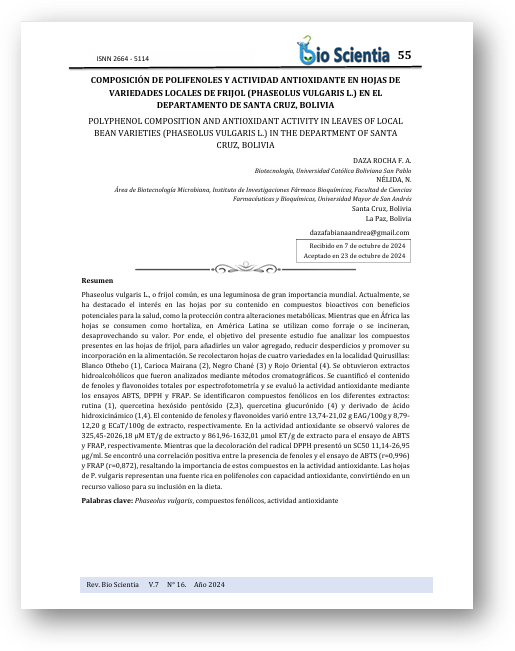POLYPHENOL COMPOSITION AND ANTIOXIDANT ACTIVITY IN LEAVES OF LOCAL BEAN VARIETIES (PHASEOLUS VULGARIS L.) IN THE DEPARTMENT OF SANTA CRUZ, BOLIVIA
Keywords:
Phaseolus vulgaris, phenolic compounds, antioxidant activityAbstract
Phaseolus vulgaris L. (common bean) is a globally significant legume. Currently, interest in the leaves has been highlighted for their content of bioactive compounds with potential health benefits, such as protection against metabolic disorders. While in Africa the leaves are consumed as a vegetable, in Latin America they are used as fodder or incinerated, wasting their value. Therefore, the objective of the present study was to analyze the compounds present in bean leaves, to add value to them, reduce waste and promote their incorporation into the diet. Leaves of four varieties were collected in the Quirusillas locality: Blanco Othebo (1), Carioca Mairana (2), Negro Chané (3) and Rojo Oriental (4). Hydroalcoholic extracts were obtained and analyzed by chromatographic methods. Total phenol and flavonoid content was quantified by spectrophotometry and antioxidant activity was evaluated by ABTS, DPPH and FRAP assays. Phenolic compounds were identified in the different extracts: rutin (1), quercetin hexoside pentoside (2,3), quercetin glucuronide (4) and hydroxycinnamic acid derivative (1,4). The phenol and flavonoid contents ranged from 13.74-21.02 g EAG/100g and 8.79-12.20 g ECaT/100g of extract, respectively. In antioxidant activity, values of 325.45-2026.18 μM ET/g extract and 861.96-1632.01 μmol ET/g extract were observed for ABTS and FRAP assay, respectively. While DPPH radical decolorization presented SC50 11.14-26.95 μg/ml. A positive correlation was found between the presence of phenols and the ABTS (r=0.996) and FRAP (r=0.872) assay, highlighting the importance of these compounds in antioxidant activity. P. vulgaris leaves represent a rich source of polyphenols with antioxidant capacity, making them a valuable resource for inclusion in the diet.



